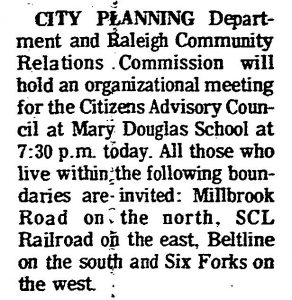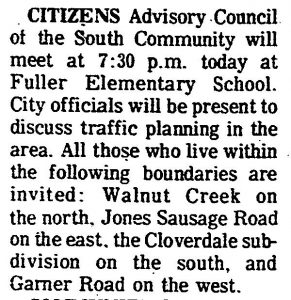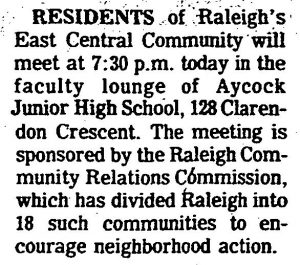I conducted my first East Citizens Advisory Council (East CAC) meeting for the first time in years. It’s been a year since the CAC met but it felt good to be doing something again.
I thought it was prudent to create a presentation about CACs, since there are new neighbors in the area who aren’t familiar with them. I’m also slated to talk to the Wake One Water group (a Wake County board) about CACs this Friday and a presentation could be useful for that call as well.
I slapped some slides together at the last minute, putting in the “facts” that I had assembled over the years of participating in CACs. There were holes in my knowledge, though, that drove me to do some research today on the murky early days of CACs. What I found surprised me.
I was able to finally view archives of the Raleigh News and Observer through the State Library and searched these for mentions of CACs. Of course I found mentions from 1974, the year commonly stated as the birth year of CACs. As I kept digging, I was surprised that more mentions came up. Earlier.
Many of them in 1973.
The first mention I could find comes in the News and Observer from March 12, 1973:
CITIZENS Advisory Council of the South Community will meet at 7:30 PM today at Fuller Elementary School. City officials will be present to discuss traffic planning in the area. All those who live within the following boundaries are invited: Walnut Creek on the north, Jones Sausage Road on the east, the Cloverdale subdivision on the south, and Garner Road on the west.
An entry from October 10, 1973 hints of the citywide structure of CACs:
Residents of Raleigh’s East Central Community will meet at 7:30 PM today in the faculty lounge of the Ayock Junior High School, 128 Clarendon Cresent. The meeting is sponsored by the Raleigh Community Relations Commission, which has divided Raleigh into 18 such communities to encourage neighborhood action.
Then there’s this entry from September 20, 1973, seeming to indicate the CACs are a project of the Raleigh Community Relations Commission:

City Planning Department and Raleigh Community Relations Commission will hold an organizational meeting for the Citizens Advisory Council at Mary Douglas School at 7:30 PM today. All those who live within the following boundaries are invited: Millbrook Road on the north, SCL Railroad on the east, Beltline on the south and Six Forks on the west.
Mr. Clarence Lightner, Raleigh’s first (and as of yet, only) African-American mayor, has been traditionally credited with the creation of CACs. Yet, Mr. Lightner was not elected mayor until the November 1973 municipal election. Clearly, CACs were around at least as early as March 1973. It’s important to note that Mr. Lightner could still have been the key to CAC creation in his role as a city councilmember prior to becoming mayor.
I’m still tracking down the minutes of the various boards which could’ve been involved at the time. I’ll let you know what I find.

